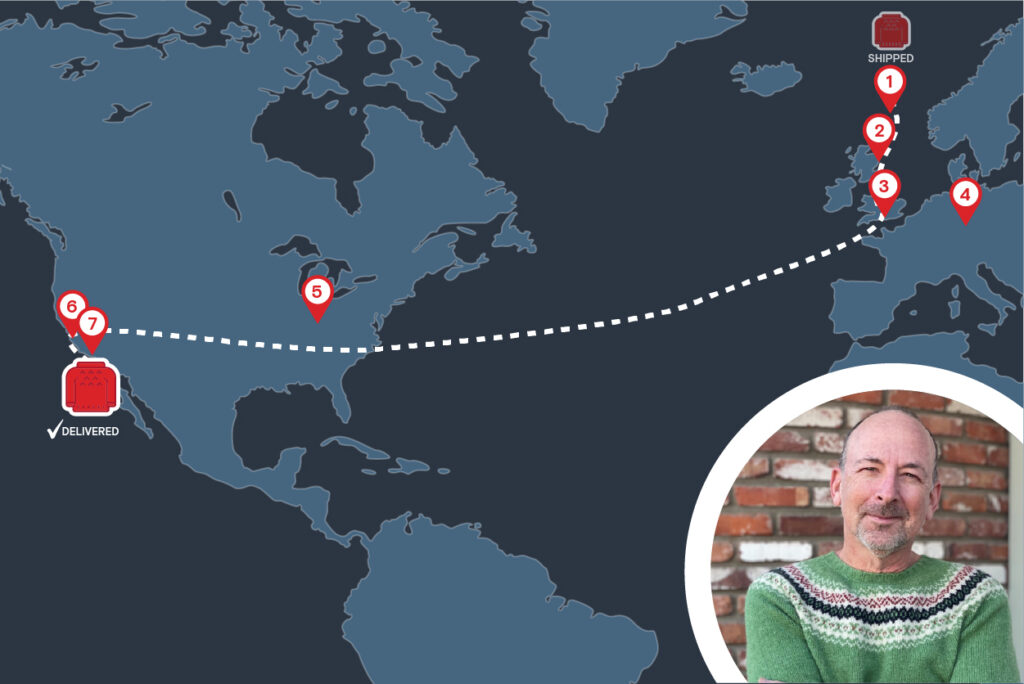
December 22 was suspenseful. It was two days until Christmas Eve when holiday deliveries would conclude and, as far as I knew, my newly ordered Shetland wool sweater was no closer to arriving at my California home than a DHL Express sorting facility at London’s Heathrow Airport. The timeframe seemed especially tight because I expected the package would need to pass through two DHL freight hubs before reaching me.
Could the global supply chain, doubly stressed by COVID and the Christmas rush, possibly come through? I downloaded DHL’s tracking app and sighed. DHL promised my package by Dec. 29. I wanted to wear my sweater to Christmas Eve dinner.
The sweater — a Christmas gift to myself — was offered by a London menswear store called John Simons. The retailer had collaborated with British rock musician Paul Weller on a line of Shetland wool sweaters using the traditional Fair Isle pattern. I’m a huge Weller fan from his days with the Jam and saw his sweaters referenced on Twitter. I ordered one online on Dec. 18. The store charged 15£ ($20.51) for shipping and hinted delivery by Christmas was possible, at least within the U.K. I called the store and learned my sweater would go out the door with DHL on the afternoon of Dec. 22. That was cutting it awfully close.
DHL is less visible than FedEx and UPS in the United States because it only does international delivery, but it’s a powerhouse in that business. The shipper has 320 aircraft in its global aviation network, having added 40 in 2021. It has major air freight hubs in Leipzig, Germany, and Cincinnati plus others in Asia.
Greg Hewitt, CEO of DHL Express USA, told me he ramped up to deal with COVID and Christmas by both adding and limiting service. With the oceangoing cargo business jammed by the pandemic, he protected air customers by allowing them to increase business by 15% but no more.
“We started very early to cap what we could move because we did have some issues (in mid-2020) in our Cincinnati hub,” Hewitt said. The big difference between air cargo and ocean shipping is the length of time and complexity of the journey. Because ships are at sea for weeks and then must navigate massive port operations, logjams have become impossible to untangle. Air freight, a day-to-day business, can address gridlock almost instantly. “Even in a really bad situation over the course of a week, we can clean it out, limit it, and move through all our stuff,” he said. “It’s just a different model.”
Hewitt said he expected DHL Express’ business in the U.S. would show growth of 20% to 30% for 2021, slowing to the 10% growth range in 2022. For Christmas 2021, Hewitt said DHL increased airlift capacity 12% into the U.S. by adding flights and buying cargo space on other carriers. “I don’t think most people recognize just how much freight moves in the bellies of those passenger aircraft we travel on,” he said.
My sweater started life as wool keeping a sheep warm on the Shetland Islands, a remote Scottish archipelago in the North Atlantic. The John Simons shop, which works with London manufacturers to make much of its in-house brand clothing, teamed up with Weller to design the line of Scottish sweaters, and they used a Shetland apparel-maker.
Paul Simons, the shop’s owner, explained on his website that he relied on local manufacturers to keep better control of the product: “If you outsource to a manufacturer overseas, you run the risk of decisions being made on your behalf and often mistakes can be made which could have been avoided.”
When I called to learn more, Simons told me the store worked quickly to order 500 of the sweaters for the holidays. The schedule was nearly upended by bad Shetland weather: The sweaters were shipped via ferry from Lerwick to Aberdeen, a 12-hour journey, and then by truck to London. But storms delayed departure. “That does happen with our supply from the Shetlands,” Simons said. “It very much depends on fair weather for the ship to make the crossing.”
It was 4:28 a.m. on Dec. 23 in California when the app showed my package had departed DHL’s Heathrow facility, but where was it headed? To Germany and then Cincinnati? The clock was ticking.
Hewitt said if the sweater had been sent direct from Scotland it would have departed the U.K. via the East Midlands Airport near Nottingham, then transited at Leipzig for Cincinnati before L.A. No way would I have gotten it for Christmas. But there’s enough demand between London and major U.S. cities, including Los Angeles, for DHL to fly its own planes on those routes and supplement that service via other carriers. “The more product we can move direct into those markets, it puts them closer to their delivery destination and takes pressure off Cincinnati,” Hewitt said.
That’s how my sweater made it as far as LAX by 1:16 a.m. PST Friday Dec. 24, via a Boeing 777 operated by AeroLogic, a joint venture of DHL and Lufthansa.
I woke up Christmas Eve morning to see more progress on the app. My package had departed the DHL facility at LAX at 6:48 a.m., made a stop at the Santa Ana, Calif., delivery depot, and by 9:06 a.m. was in the hands of a DHL courier on his way to my door in Newport Beach.
I received my package on Dec. 24 at 12:40 p.m., 52 hours after it left John Simons, with six hours to spare before Christmas Eve dinner.
DHL had done it. In the time of COVID, this was, if not a Christmas miracle, an impressive show of resilience and planning by the global supply chain.
Read the complete Issue 2 of ChainMail here.
Enjoying this story? Subscribe to ChainMail, MxD’s newsletter on breaking supply chain news, trends, and updates.
